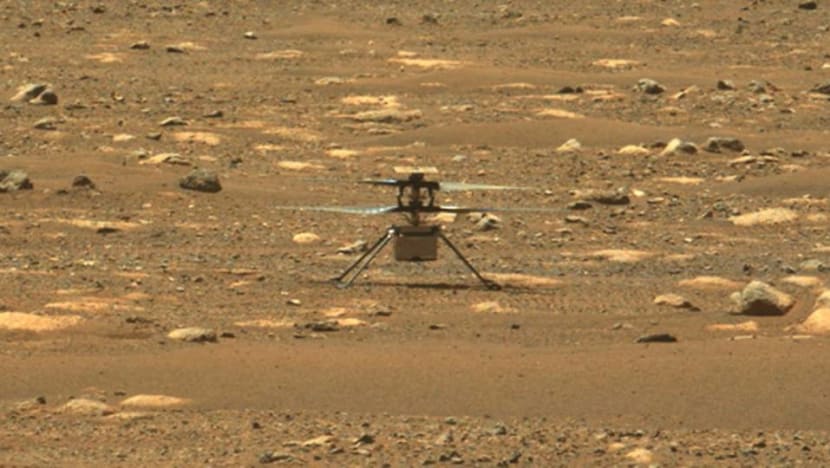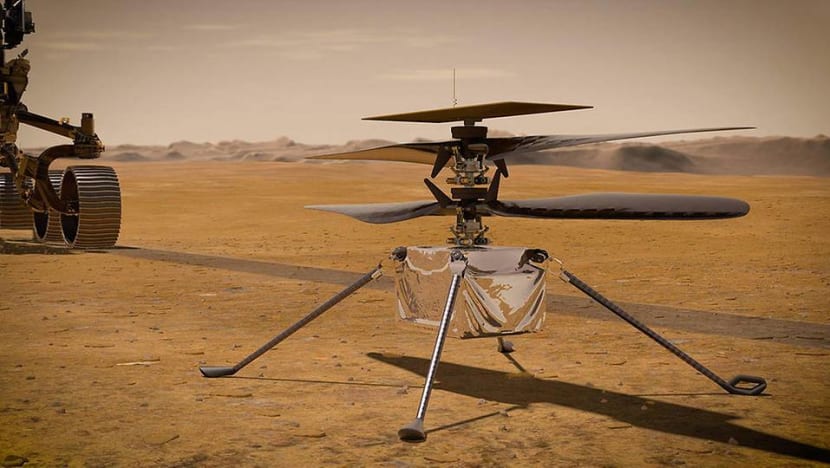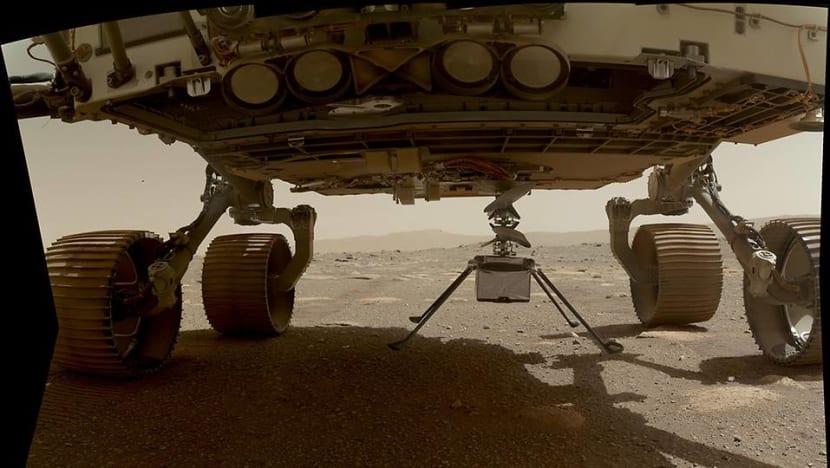'Part of history in the making': How a Singapore team helped a mini helicopter fly autonomously on Mars

NASA's Mars helicopter Ingenuity before its first flight as seen by the Mars rover Perseverance. (Photo: NASA/JPL-Caltech/ASU)
SINGAPORE: When Mr Yeoh Li Song heard that his team at the chipset maker Qualcomm was going to work with the National Aeronautics and Space Administration (NASA) on a project that was literally out-of-this-world, he was thrilled.
The Qualcomm director of engineering and six colleagues in Singapore were put in charge of testing the processor chip that acted as the brain of NASA's Ingenuity, a 1.8kg helicopter about the size of a tissue box.
The space agency hoped to autonomously fly Ingenuity on Mars in what would be the first powered and controlled flight on another planet.
The experimental mission is aimed at paving the way for aerial exploration of Mars and other places in the solar system, like Venus or Saturn’s moon Titan.

But for Ingenuity to receive and execute commands for the autonomous operation 278 million kilometres from Earth, its processor chip – which tells the machine what to do in areas ranging from flying and navigation to taking photos – must simply work the way it was designed to.
Furthermore, the chip must endure the extreme conditions that Ingenuity would be exposed to, including radiation and the cold evenings on Mars - where temperatures could drop below minus 60 degrees Celsius.
READ: Historic Mars helicopter test flight set for early April
This meant that the chip needed to be evaluated strenuously using robust tests, a process Mr Yeoh called "performance characterisation". And this is where Mr Yeoh's team steps in.
"Obviously, the team was very excited to contribute to the performance characterisation of the design within the chip," said the 48-year-old Mr Yeoh.
"When there's a failure, we need to spend significant time to understand the issue and to basically fix it. It is a very rigorous process as well for us."
HOW THE PROCESSOR SUITS INGENUITY
Mr Yeoh and his team are no strangers to testing Qualcomm's Snapdragon 801 processor, which can be found in many smartphones and tablets today.
"Our team develops the test solutions, verifies the design of the chip and brings it to commercial production," he said.

The Snapdragon processor is also the basis for Qualcomm's flight platform, which the company said comes in an "extremely small and durable package" and focuses on features like ultra-high-definition video and flight assistance. The flight platform is also used in consumer drones.
"These were all features that came to mind when JPL considered the constraints of remotely operating a helicopter on Mars, and the complex algorithms the helicopter would need to compute," Qualcomm said on its website.
JPL refers to NASA's Jet Propulsion Laboratory, which built Ingenuity.
While the Qualcomm Singapore team is used to testing the Snapdragon processor, Mr Yeoh said putting it in a helicopter bound for Mars is a "totally different thing".
"This particular Snapdragon processor that actually went into Ingenuity is one of the first major projects for the Singapore team," he added.
TESTING AND RE-TESTING
A major project like this would not come without challenges, and Mr Yeoh said this included a lot of extreme testing, repeat testing and collecting troves of data over nine months. Qualcomm declined to give exact project dates, citing internal policies.

Occasionally, the issue might not be with the chip, but with the test itself.
The team, for instance, once tested the chip in freezing temperatures by hitting it with a jet of cold air and discovered that it was not producing the correct results.
"We needed to check if it was due to the programme, the silicon (on the chip), the software or things like that," Mr Yeoh said.
"There are so many different pieces that could go wrong as well, so we just have to eliminate step by step and understand the root cause."
This tedious process could also involve something called "failure analysis", where the chip - which contains structures so small they cannot be seen by the naked eye - is examined using x-rays.
READ: NASA's astrobiology rover Perseverance makes historic Mars landing
The team kept repeating the cold test and analysing the data, and found that the issue was linked to the test. They tweaked the test programme and the chip eventually passed.
"So, it was more understanding that and fixing the programme ... the silicon itself was still good actually," Mr Yeoh added.
A HUGE CELEBRATION
Nevertheless, Mr Yeoh said the team remained "motivated" despite the grind, especially as it was also testing high-speed interfaces in the processor for the first time. These interfaces connect to different parts of Ingenuity, including its camera.
"This was one of the few major projects that we started and we were learning a lot actually. So, it didn’t feel like a dull moment," he added.

When news emerged that NASA would soon attempt Ingenuity's maiden flight, the team followed the updates religiously.
"A few of us were eagerly awaiting the news on when Ingenuity will actually take flight and whether the first flight would successful," Mr Yeoh said, highlighting that this started when NASA's rover Perseverance, which carried Ingenuity, landed on Mars in February.
"It took a while before the helicopter got launched. I guess it is a very delicate thing – there were a few days when they unwrapped it and then tried to keep it warm.
"A few of us were following the news quite closely, texting each other, saying it’s going to be soon."

Then on Apr 9, NASA discovered a technical glitch during a test spin of the helicopter's rotors, delaying the launch by a week.
But as far as Ingenuity's processor was concerned, Mr Yeoh said his team was sure it would work.
"We wanted to know that it actually works, but we were quietly very confident," he said.
READ: NASA's Mars helicopter takes flight, 1st for another planet
Finally on Apr 19, it happened.
Flight controllers in California confirmed Ingenuity’s brief hop after receiving data via Perseverance, which stood watch more than 65m away.
Mr Yeoh and his colleagues texted each other their congratulations, as Qualcomm's engineers in California who also worked on the project celebrated at a huge viewing party.
Some of the team members in Singapore also tuned in virtually to the viewing party. If it was not for the COVID-19 pandemic, the Singapore team would have had its own in-person celebration too.

Mr Yeoh said his team was "very thankful for this opportunity to be part of history in the making".
"We feel proud and I will say it is a huge affirmation and recognisation of the engineering skill sets developed in Qualcomm Singapore," he added.
"Because a lot of times, I think people tend to focus more on the front-end stuff like how the wafers were manufactured or how the design came about.
"But I think product and test development is an equally important piece of work. And I think this kind of reminds us that what we do is important as well."












